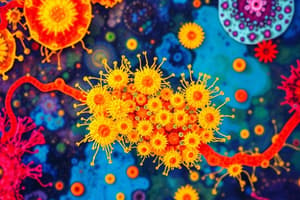Podcast
Questions and Answers
What is the generation time in bacterial growth?
What is the generation time in bacterial growth?
- Time taken for bacteria to decrease in number
- Time taken for bacteria to enter the stationary phase
- Time taken for bacteria to complete their lag phase
- Time taken for bacteria to double their population (correct)
During which phase of bacterial growth does exponential increase occur?
During which phase of bacterial growth does exponential increase occur?
- Stationary phase
- Log phase (correct)
- Lag phase
- Death phase
Which method is least suitable for identifying heat-sensitive microbes?
Which method is least suitable for identifying heat-sensitive microbes?
- Membrane filtration
- Serial dilutions + plate count
- Pour plate method (correct)
- Spread plate method
Which technique is used for measuring the optical density of microbial cultures?
Which technique is used for measuring the optical density of microbial cultures?
What does a stationary phase indicate in bacterial growth?
What does a stationary phase indicate in bacterial growth?
What term describes organisms that thrive best at temperatures well above 100 °C?
What term describes organisms that thrive best at temperatures well above 100 °C?
Which type of microorganism is likely to be found in highly saline environments?
Which type of microorganism is likely to be found in highly saline environments?
What type of culture medium is defined by having a known and exact chemical composition?
What type of culture medium is defined by having a known and exact chemical composition?
Which of the following best describes facultative anaerobes?
Which of the following best describes facultative anaerobes?
What is the process called when planktonic cells attach to a surface and form a biofilm?
What is the process called when planktonic cells attach to a surface and form a biofilm?
Which of the following best describes a microaerophile?
Which of the following best describes a microaerophile?
Which technique would best preserve bacterial cultures for long-term storage?
Which technique would best preserve bacterial cultures for long-term storage?
What type of media would best support the growth of specific microbes while suppressing unwanted species?
What type of media would best support the growth of specific microbes while suppressing unwanted species?
Flashcards are hidden until you start studying
Study Notes
Microbial Growth Requirements
-
Physical Requirements:
- Temperature:
- Minimum growth temperature: Lowest temperature at which a species can grow.
- Optimum growth temperature: Temperature at which a species grows best.
- Maximum growth temperature: Highest temperature at which a species can grow.
- Temperature classifications:
- Psychrophilic: Grow at low temperatures (0-20°C).
- Psychrotroph: Prefers moderate temperatures (20-30°C) but can grow at low temperatures (0°C).
- Mesophilic: Grow at moderate temperatures (20-45°C).
- Thermophilic: Grow at high temperatures (45-70°C).
- Hyperthermophilic: Grow at very high temperatures (70°C and above).
- pH:
- Acidophile: Optimum growth at low pH (below 5.5).
- Neutrophile: Optimum growth at neutral pH (around 7).
- Alkaliphile: Optimum growth at high pH (above 8.5).
- Osmotic pressure:
- Halophile: Requires high salt concentration for growth.
- Extreme halophile: High salt concentration is essential for growth.
- Haltolerant: Can tolerate high salt concentrations but do not require it for growth.
- Temperature:
-
Chemical Requirements:
- Carbon:
- Chemoheterotroph: Obtain carbon from organic compounds.
- Chemoautotroph: Obtain carbon from inorganic compounds.
- Nitrogen, Phosphorus, Sulfur, and Trace Elements: Essential for microbial growth.
- Oxygen:
- Obligate aerobes: Require oxygen for growth.
- Obligate anaerobes: Cannot grow in the presence of oxygen.
- Facultative anaerobes: Can grow with or without oxygen, but grow better in the presence of oxygen.
- Aerotolerant anaerobes: Can tolerate oxygen but do not utilize it for growth.
- Microaerophiles: Require oxygen for growth but only at low concentration.
- Carbon:
Biofilm
- A complex polymer containing communities of bacteria.
- Formation:
- Planktonic bacteria attach to a surface.
- Monolayer formation and slime production.
- Multilayering of cells.
- Development of pillar-like structures with channels.
- Cells detach and revert to planktonic form.
- Communication:
- Quorum sensing: Bacteria communicate within a biofilm using chemical signals to coordinate their behavior.
Culture Media
- Nutrient materials used for microbial growth in the laboratory.
- Chemically defined media: Exact chemical composition is known.
- Complex media: Composed of undefined complex ingredients, such as yeast extract or nutrient broth.
- Special culture techniques:
- Cultivation of anaerobic microbes:
- Reducing media: Contains chemicals that absorb oxygen.
- Anaerobic chamber: Removes oxygen from the environment.
- Cultivation of CO2-required microbes:
- Candle jars: Creates a CO2-enriched environment.
- CO2 incubator: Provides a controlled CO2-rich atmosphere.
- Cultivation of pathogenic microbes:
- Biosafety cabinets (BSCs):
- Level 2 microbes: Standard BSC for containment.
- Level 3 microbes: BSC with directional airflow for additional protection.
- Bioseal personal protective equipment (PPE): Required for Level 4 microbes.
- Biosafety cabinets (BSCs):
- Selective and differential media:
- Selective: Inhibit the growth of unwanted species.
- Differential: Distinguish desired species from others.
- Combined: Mannitol salt agar is both selective and differential for Staphylococcus aureus.
- Enrichment culture: A selective medium for favoring the growth of desired species.
- Cultivation of anaerobic microbes:
Bacterial Cultures
- Pure culture: Contains only one species of bacteria.
- Streak plate method: Used to isolate individual colonies of bacteria.
- Preserving Bacterial Cultures:
- Deep-freezing: Storing pure cultures suspended in liquid at -80°C.
- Lyophilisation (freeze-drying): Freezing the culture at -80°C, removing water by vacuum, and sealing in glass containers.
- Bacterial division:
- Binary fission: Bacteria divide by splitting into two identical daughter cells.
- Bacterial Growth:
- Generation time: Time taken for bacteria to double their population size.
- Phases of growth:
- Lag phase: Intense metabolic activity in preparation for growth, but no increase in population.
- Log phase: Exponential increase in population.
- Stationary phase: Growth rate slows and population reaches equilibrium.
- Death phase: Population decreases due to cell death.
- Direct measurement of microbial growth:
- Serial dilutions + plate count:
- Colony forming units (CFU): Colonies counted on plates are used to determine the original number of bacteria in the sample.
- Pour plate method: Suitable for most species, but not heat-sensitive microbes, as some may grow within the agar.
- Spread plate method: Suitable when microbial density is high.
- Membrane filtration: For low microbial densities, bacteria are filtered onto a membrane and counted.
- Serial dilutions + plate count:
- Direct microscopic count:
- Haemocytometry: Uses a special counting chamber for direct cell counting.
- Turbidity: Measures the optical density (OD) of a culture using a spectrophotometer.
- Metabolic activity: Indirectly measures growth rate by measuring the production of CO2 or acid.
- Dry weight: Measures the dry mass of a culture as a proxy for cell number.
Studying That Suits You
Use AI to generate personalized quizzes and flashcards to suit your learning preferences.




